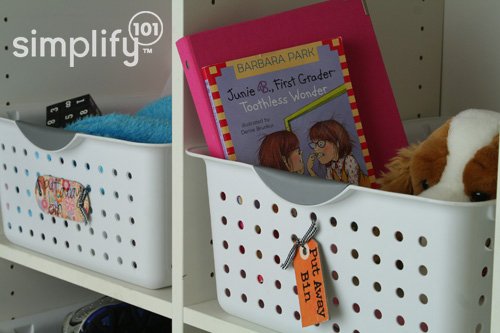A common question for participants in Quick + Simple Clutter Control is: What can I do about so-and-so’s clutter? While “so-and-so” changes—sometimes it’s a husband, other times it’s a roommate, and often so-and-so is a son or a daughter—the essence of the question is always the same: If I’m going to put in the time and effort to get organized and declutter my home, how can I make sure my efforts aren’t undermined by the clutter bug(s) I live with?
My answer may surprise you. What I always suggest is that at the onset, instead of worrying about the other clutter-bugs in your home, focus solely on you and your clutter. Now if other people in your home are contributing to the clutter situation, it’s very likely that their clutter is far more noticeable and annoying to you than your own clutter. This is why your instinct is to worry about them. But, here’s the thing: If there’s any clutter in your home with your name on it, if your so-and-so isn’t noticing it now, he most definitely will when you ask him to do something about his clutter.
When you start with yourself, you will be standing on solid ground when you ask other people to jump on the clutter-busting bandwagon later on. Furthermore, you start the process of showing your family what is now expected in your home. Begin by focusing on spaces that are yours and yours alone—such as your side of the bedroom or your craft space or your drawer in the bathroom or the laundry room, if that is your domain. This will help remove the fear that someone else will mess up your hard work—since they don’t use this space anyway — and it also shows that you’re creating these changes for you, which sends a very powerful message as well.
Share your journey.
As you start with your own pockets of clutter, share your decluttering journey with your family. Explain why you’re putting in the time and effort to declutter your spaces and get organized. Tell your family members the benefits you intend to create. Then, as you make progress on your projects, share your successes and even your roadblocks with them. Share how good it feels to clear clutter and take steps forward on an important goal. Show your family members your organized spaces so they can see how great your spaces look. In short, share your enthusiasm…because enthusiasm is contagious.
Lead by example.
When you declutter a room, the energy in that room shifts…and others will feel it, too, even if they weren’t involved in the decluttering process. As you continue on your personal organizing journey, you may begin to see, as many past participants of my online workshops have found, that others will naturally jump on the organizing bandwagon! As they hear about and see and feel the benefits you’re creating, they just may want some of that for themselves. But if not, don’t get discouraged. Simply continue on with your journey, tackling your organizing projects and creating new organized habits.
Getting your clutter-bugs on board.
Once you’re in control of your own clutter, then you’ll be sending a consistent message about the new rules of engagement in your home. If the clutter-bug(s) haven’t jumped on board on their own, this is the time to sit down and have a conversation with him, her or them. Share what you want and review the benefits you’ve experienced as a result of your organizing journey. Tell them how much more energized, yet calm and peaceful, you feel now. Share with them how confident you feel when someone goes into one of your organized areas, and tell them how much more time you have now because you no longer search through stacks and piles for your things. In short, explain how worthwhile your decluttering efforts have been for you.
Ask and listen.
Next, ask, and really listen to, what your family members want. Perhaps the people you share your home with have a different clutter comfort zone than you. It’s possible that your clutter-bugs don’t notice when their own things are out and cluttering up your space. If leaving things out is an automatic habit, then they may not even see it. Because of this, during your conversation make it your goal to reach an agreement that is a better place for both of you—one that gets you closer to your comfort zone, while recognizing and respecting that the people you share your home with may have a different perspective. You may find that your family’s comfort zone changes over time as they begin taking action on their own clutter.
Offer support.
Once you and your so-and-sos are on the same page in terms of the goal you’re both after, then ask how you can support him, her or them in achieving the new goal. It’s possible your clutter-bugs may need help setting up new systems, as well creating new habits. In other words, after you talk about how you want things to be, it will still take time for those new habits to cement. If you know that up front and act as a support system, it will help all of you.
Take it one step at a time.
When you’re at this point in the process, you’ll know that organizing is a combination of projects and habits. Just as you embarked on your organizing journey one step at time, give your family members permission to do the same. Notice their progress, and say thank you when you see them taking steps in the direction of your clutter comfort zone. As a past workshop participant said: “’Thanks’ makes a huge difference. It makes for a positive, cooperative atmosphere in our home, which is the ultimate goal.” I couldn’t agree more.

